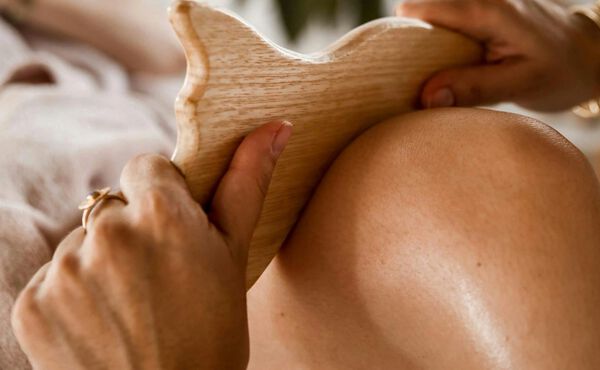Curious about fascia? Learn how to care for this essential connective tissue to help reduce pain, improve posture, and relieve stress with our expert guide.
In recent years, fascia has become a wellness buzzword – and for good reason. This often-overlooked tissue plays a vital role in managing pain, improving posture, and even reducing stress levels. Yet, for many of us, fascia remains a bit of a mystery. What is it, and how do you care for it?
This guide explores what fascia is, how it changes over time, and practical ways to keep it healthy to enhance overall wellbeing. Ready to dive in?
What is fascia in the body?
In short, fascia is the connective tissue in your body that helps everything work as it should. It’s mostly made up of collagen and comes in four main types: superficial fascia (beneath the skin), deep fascia (around muscles), visceral fascia (surrounding organs), and parietal fascia (lining areas inside the body, like the chest and abdomen).
“Fascia is often described as a ‘sheath’ of connective tissue surrounding our organs, bones, blood vessels, nerve fibres, and muscles,” explains Eloise Skinner, a fitness instructor, PT and psychotherapist. This sheath supports each structure individually but also connects them, enabling the body to function as an integrated whole.
When healthy, fascia is flexible and elastic, facilitating smooth movement. But stress, injury, or inactivity can make it tense, resulting in stiffness that feels similar to muscle tightness.
How and why fascia changes
Fascia naturally changes throughout our lives, becoming stiffer. “With age, our fascia can often become more stiff, less elastic and thicker, which can in turn lead to mobility issues and discomfort,” says Skinner. But it’s not just age that affects our fascia; activity levels, stress, and posture can play a role too.
“Not moving frequently enough, poor posture or alignment, and interestingly, emotional changes, can also impact our fascia. For example, studies have shown that depression or prolonged stress might cause it to display heightened stiffness and reduced elasticity.”
Read more: 7 mind & body tips to beat work stress
How to spot symptoms of stiff fascia
Fascia pain is often mistaken for muscle tightness or stiff joints, making it hard to identify. But if persistent aches don’t ease, it may be time to reassess your symptoms.
Fascia-related tightness often manifests as general stiffness or discomfort, particularly in the morning or after long periods of inactivity. “If you experience muscle or joint pain that eases with exercise, it might be related to fascia,” says Skinner. “More intense fascial inflammation might lead to conditions like myofascial pain syndrome, which can feel like pain in certain muscle groups, such as the neck or lower spine.”

Key fascia symptoms to look for include:
- Persistent muscle tightness: Stiff fascia can feel like muscle tightness that doesn’t improve with regular stretching, especially in areas like the neck, shoulders, or lower back.
- Pain during movement: Restricted fascia can cause discomfort during movement as the stiffness limits range of motion.
- Frequent tension headaches: Tight fascia in the upper body, particularly your neck and shoulders, can trigger tension headaches.
- Myofascial pain syndrome (MPS): This condition is characterised by tender 'trigger points', or fascial knots, within specific muscle groups.
- Decreased range of motion: Stiff fascia may reduce flexibility, particularly in the hips, lower back, and shoulders.
- Plantar fasciitis: Tight fascia in the feet can lead to inflammation on the sole, causing heel pain.
Read more: Feeling stiff in the morning? This 15-minute joyful yoga flow
DIY tips to look after your fascia
You can start taking better care of your body’s fascia right away, with simple DIY techniques and stretches that can be at home to relieve tension and support overall wellbeing as well as your fascia health. Spoiler alert: yoga for flexibility and DIY massage are key.
- Gua Sha body massage: Use a Gua Sha tool on muscles in the back, shoulders, and legs to promote circulation and reduce stiffness.
- Downward Dog stretch: Skinner recommends this yoga position to stretch fascia in the legs and feet. Lift your hips, reaching your head and hands towards the ground, and pedal your legs to deepen the stretch. Our beginner yoga session is a good place to start.
- Foam roller for lower back: Lie on your back with a foam roller under the lower back. Bring your knees towards you and shift your hips to one side, then repeat on the other side.
- Tennis ball rolling for feet: One of Skinner’s favourites for the fascia in your feet. Roll a tennis ball along the arch of your foot, pausing on tight spots to relieve tension.
- Cat-Cow stretch: On all fours, slowly alternate between a rounded and arched spine, allowing fascia across the back to stretch.
- Hip flexor stretch: Hold onto a counter for support, shift your weight to one leg, and pull the opposite heel towards your glutes to stretch the hip fascia. For this one, Skinner advises holding onto a countertop for support.
Read more: Fascia stretch therapy for brighter skin and a stronger body
The benefits of fascia therapy
While DIY methods are a great way to look after your fascia health from home, for persistent or severe pain it’s best to seek out professional fascia therapy. “Fascia therapy can vary in approaches, but often involves stretching and releasing tightness in the fascial tissues,” explains Skinner.
“Fascia stretching can promote circulation, allowing improved blood flow to muscles, reducing tension, and enhancing fitness performance. It can also help to improve our range of motion, making movement easier and more comfortable, and reducing the risk of injury.”
To find a qualified fascia therapist near you, consider looking for specialists in physiotherapy, massage therapy, or osteopathy. Many physical therapists offer fascial treatments tailored to individual needs. Research online, read reviews, and seek recommendations to find a trusted practitioner in your area.
Read more: What is awareness & why does it matter?








